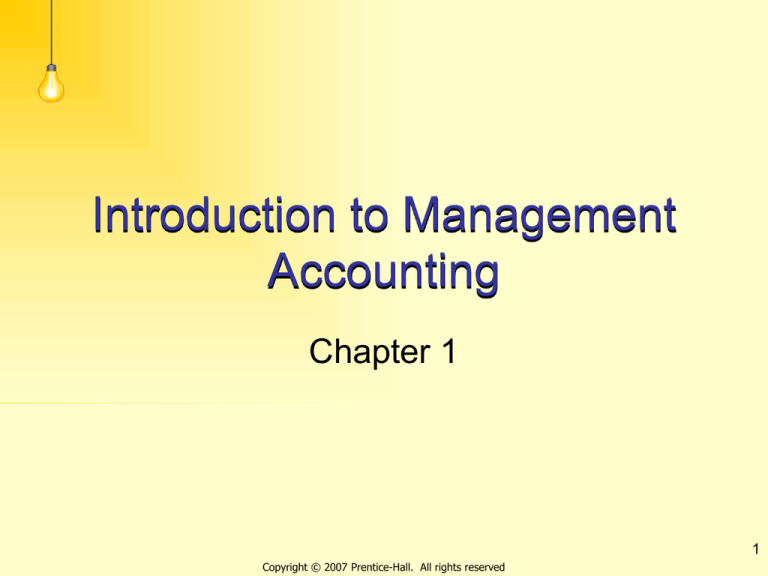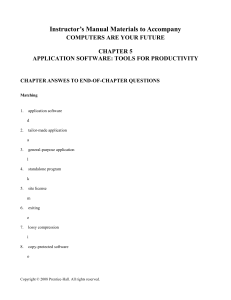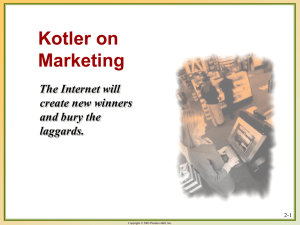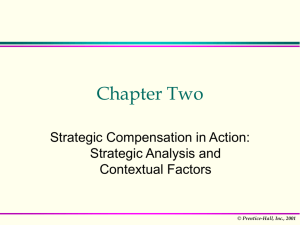
Introduction to Management
Accounting
Chapter 1
1
Copyright © 2007 Prentice-Hall. All rights reserved
Objective 1
Identify managers’ four primary
responsibilities
2
Copyright © 2007 Prentice-Hall. All rights reserved
Managers’ Responsibilities
Decision
Making
Planning
Setting goals and
objectives
Directing
Overseeing day-today operations
Controlling
Evaluating results
of operations
3
Copyright © 2007 Prentice-Hall. All rights reserved
Objective 2
Distinguish financial accounting
from management accounting
4
Copyright © 2007 Prentice-Hall. All rights reserved
Primary Users?
Management
• Internal
• Managers
Financial
• External
• Investors, creditors,
government
regulators
5
Copyright © 2007 Prentice-Hall. All rights reserved
Purpose of Information?
Management
• Help managers plan,
direct, and control
business operations
Financial
• Help investors and
creditors make
investment and credit
decisions
6
Copyright © 2007 Prentice-Hall. All rights reserved
Primary Accounting Product?
Management
• Any internal
accounting report
deemed worthwhile
by management
Financial
• General-purpose
financial statements
7
Copyright © 2007 Prentice-Hall. All rights reserved
What must be included?
Management
• Whatever
management needs
as long as benefits of
using report exceeds
cost of preparing it
Financial
• Determined by GAAP
8
Copyright © 2007 Prentice-Hall. All rights reserved
Underlying basis of the
information?
Management
• Focus on future
• Information on
external and internal
transactions
Financial
• Based on historical
transactions
• External transactions
9
Copyright © 2007 Prentice-Hall. All rights reserved
Information characteristic
emphasized?
Management
• Relevance
Financial
• Reliable and objective
10
Copyright © 2007 Prentice-Hall. All rights reserved
Business unit?
Management
• Segments – products,
geographical regions,
customers
Financial
• Company as a whole
11
Copyright © 2007 Prentice-Hall. All rights reserved
How often prepared?
Management
• Depends on
management needs
Financial
• Annually and
quarterly
12
Copyright © 2007 Prentice-Hall. All rights reserved
Verification?
Management
• No independent
audits
• Internal audits may
occur
Financial
• Independent audits of
publicly traded
companies
13
Copyright © 2007 Prentice-Hall. All rights reserved
Required by outside group?
Management
• No
Financial
• Yes – SEC for publicly
traded companies
14
Copyright © 2007 Prentice-Hall. All rights reserved
Concern over how reports affect
employee behavior?
Management
• Yes
Financial
• Concern is about
adequacy of
disclosure
15
Copyright © 2007 Prentice-Hall. All rights reserved
E1-10
a. Companies must follow GAAP in their
Financial accounting
____________________
systems.
b. Financial accounting develops reports for
external parties, such as __________
Creditors
Shareholders
and _______________.
c. When managers evaluate the company’s
performance compared to the plan, they
Controlling role of
are performing the __________
management.
16
Copyright © 2007 Prentice-Hall. All rights reserved
E1-10
d. __________
Managers are decision makers inside
a company.
e. ___________________
Financial accounting provides
information on a company’s past
performance to external parties.
Management accounting systems are
f. ______________________
not restricted by GAAP but are chosen
by comparing the costs versus the
benefits of the system.
17
Copyright © 2007 Prentice-Hall. All rights reserved
E1-10
g. Choosing goals and the means to
Planning function
achieve them is the __________
of management.
h. _____________________
Managerial accounting systems report
on various segments or business units of
the company.
Financial accounting
i. ____________________
statements of
public companies are audited annually by
CPAs.
18
Copyright © 2007 Prentice-Hall. All rights reserved
Objective 3
Describe organizational structure and the
roles and skills required of management
accountants within the organization
19
Copyright © 2007 Prentice-Hall. All rights reserved
Organizational Structure
Board of
Directors
Audit
Committee
Chief Executive
Officer
Chief Operating
Officer
Vice Presidents
of various
operations
Chief Financial
Officer
Treasurer
Controller
Internal Audit
20
Copyright © 2007 Prentice-Hall. All rights reserved
Management Accountants
• Often part of cross-functional teams
• Report to various vice-presidents of
operations
• Role is to analyze financial impact of
business decisions
• Internal consultants
21
Copyright © 2007 Prentice-Hall. All rights reserved
Roles of Management
Accountants
• Ensuring accurate financial records
– Helping to design information systems
– Recording non-routine transactions
– Making adjustments to financial records
• Planning, analyzing, and interpreting
accounting data
• Providing decision support
22
Copyright © 2007 Prentice-Hall. All rights reserved
Required Skills
• Knowledge of financial and managerial
accounting
• Analytical skills
• Knowledge of how a business functions
• Ability to work on a team
• Oral and written communications skills
23
Copyright © 2007 Prentice-Hall. All rights reserved
E1-11
a. The _____
CFO and the _____
COO report to the
CEO.
b. The internal audit function reports to the
audit committee
CFO or _______
CEO and the _____________.
c. The __________
is directly responsible for
controller
financial accounting, managerial
accounting, and tax reporting.
Board of Directors
d. The CEO is hired by the _____________.
24
Copyright © 2007 Prentice-Hall. All rights reserved
E1-11
e. The __________
treasurer is directly responsible
for raising capital and investing funds.
f. The __________
is directly responsible
COO
for the company’s operations.
g. Management accountants often work
cross functional teams
with __________________________.
h. The subgroup of the board of directors is
audit committee
called the _________________.
25
Copyright © 2007 Prentice-Hall. All rights reserved
Objective 4
Describe the role of the Institute of
Management Accountants (IMA) and use
its ethical standards to make reasonable
ethical judgments
26
Copyright © 2007 Prentice-Hall. All rights reserved
IMA
• Professional association for managerial
accountants
• Goal
– Advance management accounting profession
– Educate society about role of managerial
accountants
• Certifications
– Certified Management Accountant (CMA)
– Certified Financial Managers (CFM)
27
Copyright © 2007 Prentice-Hall. All rights reserved
Ethics
• Statement of Ethical Professional Practice
(IMA)
– Maintain professional competence
– Preserve confidentiality of information
– Uphold their integrity
– Perform duties with credibility
– Consult an attorney
28
Copyright © 2007 Prentice-Hall. All rights reserved
Steps to Resolve
Ethical Dilemmas
• Follow company’s policies for reporting
unethical behavior
• If not resolved
– Discuss with immediate supervisor
– Discuss with objective advisor
29
Copyright © 2007 Prentice-Hall. All rights reserved
E1-13
a. The ______
IMA
is the professional
association for management
accountants.
b. The institute offers two types of
certification: The _____
CMA and _____.
CFM
CMA
c. The __________
exam focuses on
managerial accounting topics,
economics, and business finance.
30
Copyright © 2007 Prentice-Hall. All rights reserved
E1-13
CFM exam focuses on financial
d. The ______
statement analysis, business valuation,
risk management, working capital policy,
and capital structure.
e. The institute’s monthly publication, called
________________,
addresses current
Strategic Finance
topics of interest to managerial
accountants.
31
Copyright © 2007 Prentice-Hall. All rights reserved
E1-13
f. The institute says that approximately
85 percent of accountants work inside
_____
of organizations, rather than at CPA firms.
32
Copyright © 2007 Prentice-Hall. All rights reserved
Objective 5
Discuss trends in the business
environment
33
Copyright © 2007 Prentice-Hall. All rights reserved
Sarbanes-Oxley Act of 2002
• CEO and CFO - responsible for financial
statements, internal control system,
procedures for financial reporting
• Audit committee – independent and should
include a financial expert
• CPA firms – limited non-audit services for
audit clients and periodic quality review
• Stiffer penalties for white-collar crimes
34
Copyright © 2007 Prentice-Hall. All rights reserved
Trends
• Shift toward service economy
• Competing in global marketplace
• Time-based competition
– ERP systems
– E-Commerce
– Just-in-Time Management
• Total Quality Management
35
Copyright © 2007 Prentice-Hall. All rights reserved
Trends
• Cost-Benefit Analysis – weighing costs
against benefits to help make decisions
36
Copyright © 2007 Prentice-Hall. All rights reserved
Today’s Business Trends
• Shift toward a service economy
• Global competition
• Time-based competition
– Advanced information systems
– E-Commerce
– Just-in-Time management
• Total Quality Management
37
Copyright © 2007 Prentice-Hall. All rights reserved
E1-16
a. To account for uncertainty in the amounts
of future costs and benefits, we compute
the ______________
expected value by multiplying the
probability of each outcome by the dollar
value of that outcome.
b. To make a cost-benefit decision today, we
present value
must find the ______________
of the
costs and benefits that are incurred in the
future.
38
Copyright © 2007 Prentice-Hall. All rights reserved
E1-16
c. The goal of _______
TQM
is to meet
customers’ expectations by providing them
with superior products and services by
eliminating defects and waste throughout
the value chain.
39
Copyright © 2007 Prentice-Hall. All rights reserved
E1-16
d. Most of the costs of adopting ERP, JIT,
expanding into a foreign market, or
improving quality are incurred in the
present
________,
but most of the benefits occur
in the _______.
future
40
Copyright © 2007 Prentice-Hall. All rights reserved
E1-16
e. _______________
Throughput time is the time between
buying raw materials and selling the
finished products.
f. __________
serves the information needs
ERP
of people in accounting, as well as people
in marketing and in the warehouse.
g. Firms adopt __________
e-commerce to conduct
business on the Internet.
41
Copyright © 2007 Prentice-Hall. All rights reserved
E1-16
h. Firms acquire the ______________
ISO9001:2000
certification to demonstrate their
commitment to quality.
42
Copyright © 2007 Prentice-Hall. All rights reserved
Objective 6
Use cost-benefit analysis to make
business decisions
43
Copyright © 2007 Prentice-Hall. All rights reserved
E1-18
1. What are the total costs of adopting JIT?
Employee training
Streamline production process
Supplier identification
Total costs
$13,500
37,000
8,000
$58,500
44
Copyright © 2007 Prentice-Hall. All rights reserved
E1-18
2. What are the total benefits of adopting
JIT?
Savings in warehouse expenses $97,000
Lower spoilage costs
46,000
Total benefits
$143,000
45
Copyright © 2007 Prentice-Hall. All rights reserved
E1-18
3. Should Wild Rides adopt JIT? Why or
why not?
Expected total benefits
Expected total costs
Excess of benefits over costs
$143,000
(58,500)
$ 84,500
Wild Rides should adopt JIT because the
expected benefits exceed the costs.
46
Copyright © 2007 Prentice-Hall. All rights reserved
S1-8
Expected value of additional benefits:
Outcome
Benefits
Probability
Expected
value
Moderately
successful
Extremely
successful
$20 million
0.85
= $17 million
$80 million
0.15
= $12 million
$29 million
47
Copyright © 2007 Prentice-Hall. All rights reserved
S1-8
Total benefits:
Benefits already realized
Expected value of
additional benefits
Total expected benefits
Total costs
$170 million
29 million
$199 million
$200 million
48
Copyright © 2007 Prentice-Hall. All rights reserved
S1-8
The costs of $200 million just exceed the
total expected benefits of $199 million.
Under these circumstances, the quality
program does not appear to have been a
worthwhile investment.
49
Copyright © 2007 Prentice-Hall. All rights reserved
End of Chapter 1
50
Copyright © 2007 Prentice-Hall. All rights reserved









